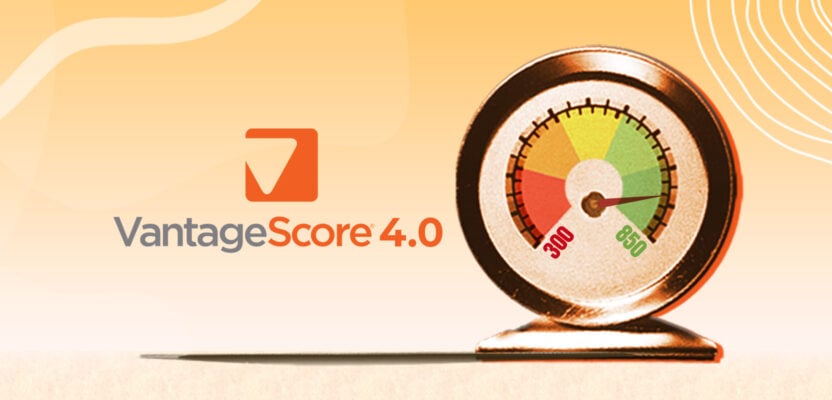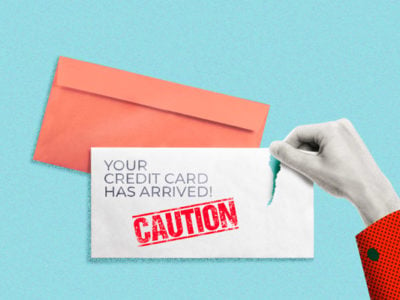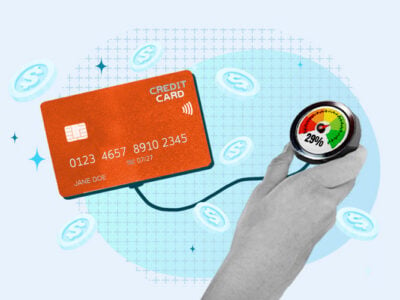If you’ve ever checked your credit score before, you probably noticed your score was provided by either FICO or VantageScore. Although FICO scores are more widely used, several major credit score checking services, like CreditKarma and CapitalOne’s CreditWise, only partner with VantageScore. However, the score they provide is based on VantageScore’s older credit-scoring model called VantageScore 3.0–not the latest model, VantageScore 4.0.
But if VantageScore 4.0 is newer and better, why is VantageScore 3.0 still much more widely used? We’ll explain that, as well as how VantageScore 4.0 differs from VantageScore 3.0 and FICO models, below.
Table of Contents
What is VantageScore 4.0?
VantageScore 4.0 is a credit-scoring model released by VantageScore Solutions LLC in 2017. That company, founded in 2006, is a joint venture between the major credit bureaus, Experian, Equifax, and Transunion. Their first model, VantageScore 1.0, was created in an effort to compete with Fair Isaac Corp (FICO) and provide an alternative credit-scoring service.
Like the credit-scoring models before it, VantageScore 4.0 is designed to analyze consumer credit report data and assess how risky it is for financial organizations (like banks or credit card companies) to lend them money or credit.
However, VantageScore 4.0 has major differences from its predecessors in terms of how it treats certain items (like collections) on credit reports, as well as how it scores people previously considered unscorable.
How is a VantageScore 4.0 credit score calculated?
A VantageScore 4.0 credit score is calculated based on positive and negative items in credit reports. The model weighs several factors, like how often you pay your bills on time, and how well you manage your credit. It then produces a number between 300 (the worst score) and 850.
We lay out how the VantageScore 4.0 credit score range works, and each credit-scoring factor below in detail.
VantageScore 4.0 credit score range & ratings
| Credit Score Range | Rating |
|---|---|
| 300-499 | Very Poor |
| 500-600 | Poor |
| 601-660 | Fair |
| 661-780 | Good |
| 781-850 | Excellent |
VantageScore 4.0 factor weights & explanations
For comparison purposes, the table below shows the credit-scoring factors and weights of both VantageScore 4.0 and VantageScore 3.0, as well as what those factors are meant to assess.
| Factor | VantageScore 4.0 Factor Weights | VantageScore 3.0 Factor Weights | What it assesses |
|---|---|---|---|
| Payment History | 41% | 40% | Whether you pay your bills on time. Paying late hurts your credit score. |
| Credit Utilization | 20% | 20% | Your debt-to-credit ratio. Using less of your credit limit helps your credit score. |
| Depth of Credit (Age/Mix) | 20% | 21% | The age of your credit accounts and the mix of credit you use. Using both credit cards and installment loans shows you’re better able to manage credit. Having older accounts (in good standing) shows you’re reliable. |
| Balances | 6% | 11% | How much debt you have. Even if you’re on top of payments, a larger balance hurts your credit. |
| Recent Credit | 11% | 5% | How many credit accounts you’ve recently opened or tried to open, resulting in hard inquiries on your credit report that hurt your credit. |
| Available Credit | 2% | 3% | How much available credit you have on your revolving accounts (i.e., your credit cards). Having more available credit helps your score. |
What’s the difference between VantageScore 4.0 and other scoring models?
VantageScore 4.0 vs. VantageScore 3.0
In terms of factor weights, the difference between VantageScore 4.0 and VantageScore 3.0 are minor.
As shown in the table above, VantageScore 4.0 does put more emphasis on Recent Credit (11% vs 5%), and less emphasis on Balances (6% vs. 11%), but overall the differences are negligible.
However, there are some major differences in terms of how it treats items on credit reports, and how it scores people who would otherwise be unscorable.
In comparison to the previous 3.0 model, VantageScore 4.0:
- Uses trended credit data to help score people more accurately. Trended credit data is gathered by monitoring credit usage patterns over an extended period (instead of the most recent credit usage only).1
- Penalizes consumers less for medical collections (compared to non-medical collections like unpaid bills for credit cards or auto loans) 2
- Ignores medical collections less than 6 months old 3
- Uses machine learning to score more people (who otherwise have nonexistent or thin credit files) more accurately
VantageScore 4.0 vs. FICO
You can’t compare VantageScore 4.0 (a credit-scoring model) and FICO (a different company that has many credit-scoring models).
However, it is useful to compare VantageScore 4.0 and FICO Score 8, the most widely used FICO credit-scoring model.
Bear in mind that VantageScore and FICO are competing companies, so their scoring models have different goals. Each company makes claims about their models being the most accurate, or most innovative. Broadly speaking, here’s how the companies define their credit-scoring models against each other.
VantageScore 4.0: Claims to score more people than previously considered possible by using machine learning techniques (without sacrificing accuracy)
FICO’s response: FICO counters these claims by implying that VantageScore can only provide credit scores to previously “invisible” consumers by relaxing standards (a claim that VantageScore denies). 4 FICO also points out that 90% of lenders use FICO scores to make lending decisions. They argue that there’s more trust in FICO to make lending decisions (due to their more stringent scoring criteria), and that’s what really counts.
FICO even goes as far as to say that VantageScore shouldn’t be considered a real credit score. They point to research showing that 85% of users who receive VantageScores aren’t aware that lenders largely don’t use VantageScore, and that 65% of users who receive a VantageScore credit score mistakenly believe they’ve received a FICO credit score. 5
FICO Score 8: Claims to score people more accurately by using stringent scoring criteria. While they can score fewer people than VantageScore, FICO argues that their model predicts consumer financial behavior more accurately.
VantageScore’s response: VantageScore counters these claims by saying that VantageScore 4.0, despite having looser scoring criteria, is more accurate than preceding models. They even imply that their credit score is as accurate, if not moreseo, than “conventional scoring models” (likely meaning FICO) when it comes to accurately predicting people’s creditworthiness.
VantageScore argues that “conventional scoring models” like FICO use outdated scoring techniques that unfairly leave out segments of the population (like students and immigrants) that are also creditworthy.
Differences between VantageScore 4.0, VantageScore 3.0, and FICO Score 8
| Category | VantageScore 4.0 | VantageScore 3.0 | FICO Score 8 |
|---|---|---|---|
| Score range | 300-850 | 300-850 | 300-850 |
| Scorable population | 252 million | 212 million | 190 million |
| Minimum credit experience needed for a score | 1 month | 1 month | 6 months |
| Hard inquiries: Buffer before impacting credit score | None | None | 30 days |
| Hard inquiries: De-duplication period | 14 days | 14 days | 45 days |
| Hard inquiries: De-duplication period applies to | All credit card and loan applications | All credit card and loan applications | All loans, but not credit cards |
| Hard inquiries: De-duplication period grouping | Groups all credit card and loan inquiries as one | Groups all credit card and loan inquiries as on | Groups inquiries by loan type: student, auto, mortgage |
| Late payment penalties | Secured debts (mortgage, auto) penalized hardest | Secured debts (mortgage, auto) penalized hardest | All penalized equally |
| Collection accounts | Ignores paid off collections | Ignores paid off collections | Ignores if the original balance was less than $100 |
Who uses VantageScore 4.0?
There isn’t much data about who uses VantageScore 4.0. VantageScore’s latest study about the market adoption of their credit-scoring models was published in 2019, but doesn’t specifically address VantageScore 4.0. 6
According to the 2019 report:
- 2,500+ lenders and other industry participants used VantageScore, pulling 12.3 billion VantageScore credit scores overall
- Those industry participants include auto lenders, personal and installment loan companies, credit card issuers, banks, credit unions, tenant screening companies, consumer websites, and government entities
- 9 of the 10 largest banks and 29 of the 100 largest credit unions used VantageScore credit scores at least some of the time (although many of them likely also used FICO scores)
- 357 million VantageScore credits cores were used in association with underwriting and account opening decisions
It’s highly likely that most of those 12.3 billion scores were calculated by VantageScore 3.0. In 2022 that may be different, but there’s no hard evidence to draw any conclusions at this time.
The bottom line is that the vast majority of lenders and financial institutions still use FICO, and those that use VantageScore largely still use VantageScore 3.0. It’s unlikely that your VantageScore 4.0 credit score is factoring into many lending decisions.
Why isn’t VantageScore 4.0 widely used?
Generally speaking, financial institutions are conservative entities. While VantageScore may claim that their 4.0 model is an improvement over 3.0, financial institutions will nonetheless be slow to adopt the newer version because the old one remains a tested and reliable way to determine creditworthiness.
Takeaway: VantageScore 4.0 still isn’t as widely used as VantageScore 3.0 or FICO Score 8
- VantageScore 4.0 is the latest model created by VantageScore Solutions LLC, a company that the credit bureaus created to compete with FICO.
- VantageScore 4.0 has several notable differences from VantageScore 3.0, the previous model in the series. For instance, it’s somewhat more lenient, especially on certain types of debt, such as medical collection accounts.
- VantageScore claims that their newest model is an improvement on their previous models and on FICO’s, although FICO strenuously disagrees.
- Because financial institutions are slow to adopt new tools and technologies, VantageScore 4.0 hasn’t achieved widespread adoption yet, and isn’t used in many lending decisions.







